Post by davep on Aug 21, 2010 20:03:10 GMT -5
At our recent meeting the discussion of wearing permanently the Red Bull patch was brought up:
Wearing of the Red Bull Patch
The question of the “Wearing of the Red Bull” patch was brought up. Tim, told the group that he would like us to follow the rule in the CHG, which says to come to events as your “unit” as you were approved. In our case that is the 442nd and 133rd regiments. Therefore we will attend events as the same unit each time regardless of the scenario, or whether our particular unit or regiments where actually there. Accordingly it will be allowed and encouraged for guys to proudly support the unit, by wearing the “Red Bull” patch on your combat jackets all year round. One of the things I want to instill is a sense of comradeship between all of us. This includes such things a commune meal, and doing things like the wearing the patch.
The question was raised about which patch; the Olive Drab border one, or the cut edge patch. Tim said for our purposes either one is fine.
Accordingly each person has the choice to wear the Red Bull patch all year round. Since it is not a requirement that you "must" wear the patch, it is important for those who chose to buy and sew on a patch, that it be a WWII era patch and not a current day patch. Also within the WWII era, there is a lot of variety in how one patch looks from another.
Before considering the patch, consider the history of the Red Bull design. During World War I the national guard units of Iowa, Nebraska, Minnesota, and the Dakotas were called into service and combat training in New Mexico in August of 1917. It was also at this same time that the Smithsonian Institute was excavating heavy jars found on the heads of skeletons of indian tribes. So this become the basis of the design of then Pvt First Class Marvin D. Cone.
Early on the men and the regimental tailors made their own patches and embellished them individually. There are records of at least 17 patches with jar and skeleton variations. Different color combinations were used and some depicted things such a the "34", "Sandstorm Division", or a particular state. Also when the 34th Infantry finally entered WWII the early patches had a "olive drab" border.
Below is Marvin Cone's orginal specs for the emblem.
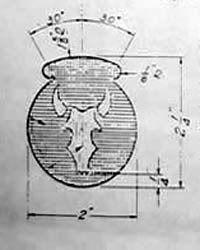
So by World War II the 34th Infantry Division already existed, and had a patch. The process of making a fully embroidered WWII patches results in a "cut edge" appearance. The edges were normally khaki or olive drab. The patches were sewn in "production line" sequence, on one continuous roll of fabric. Then each patch "and" the fabric it was sewn on, were cut out into squares. Then each square's base fabric was cut away leaving just a trace amount. This is what is refer to as a "cut edge" patch.
The norm during and after the Vietnam War, was a "merrowed edge". Many WWII Patches have a raised border that looks very close to a modern merrowed edge. WWII patches are cloth patches which have a heavy thread border applied to prevent fraying. Merrowed edges have a higher, more pronounced ridge and no cut cloth edge. Also a Merrowed edge can be usally spotted by their tail of lock stitich at the end of sewing process. So while a truly authentic construction can be spotted, some reproduction of Red Bull patches may be modern day made repros, specially the more rare OD border patches.
There are basically three types of Red Bull Patches:
1. Pre-War and Early War with the OD border - go $20 to $45
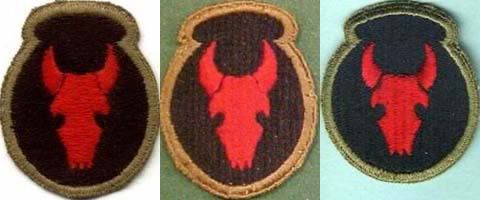
2. WWII Era - go for $8 to $15
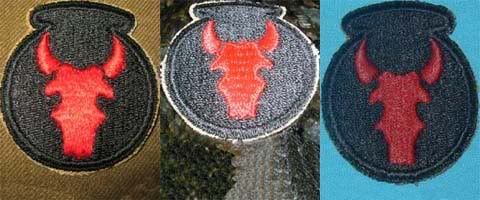
3. Modern or Post War
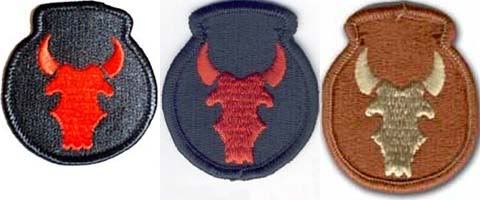
The top of the patch is worn 1/2 inch below the shoulder seam
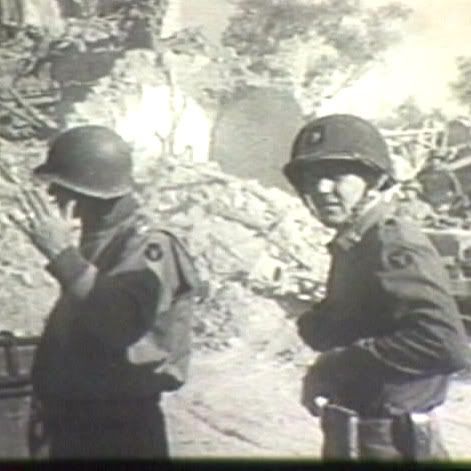
Wearing of the Red Bull Patch
The question of the “Wearing of the Red Bull” patch was brought up. Tim, told the group that he would like us to follow the rule in the CHG, which says to come to events as your “unit” as you were approved. In our case that is the 442nd and 133rd regiments. Therefore we will attend events as the same unit each time regardless of the scenario, or whether our particular unit or regiments where actually there. Accordingly it will be allowed and encouraged for guys to proudly support the unit, by wearing the “Red Bull” patch on your combat jackets all year round. One of the things I want to instill is a sense of comradeship between all of us. This includes such things a commune meal, and doing things like the wearing the patch.
The question was raised about which patch; the Olive Drab border one, or the cut edge patch. Tim said for our purposes either one is fine.
Accordingly each person has the choice to wear the Red Bull patch all year round. Since it is not a requirement that you "must" wear the patch, it is important for those who chose to buy and sew on a patch, that it be a WWII era patch and not a current day patch. Also within the WWII era, there is a lot of variety in how one patch looks from another.
Before considering the patch, consider the history of the Red Bull design. During World War I the national guard units of Iowa, Nebraska, Minnesota, and the Dakotas were called into service and combat training in New Mexico in August of 1917. It was also at this same time that the Smithsonian Institute was excavating heavy jars found on the heads of skeletons of indian tribes. So this become the basis of the design of then Pvt First Class Marvin D. Cone.
Early on the men and the regimental tailors made their own patches and embellished them individually. There are records of at least 17 patches with jar and skeleton variations. Different color combinations were used and some depicted things such a the "34", "Sandstorm Division", or a particular state. Also when the 34th Infantry finally entered WWII the early patches had a "olive drab" border.
Below is Marvin Cone's orginal specs for the emblem.

So by World War II the 34th Infantry Division already existed, and had a patch. The process of making a fully embroidered WWII patches results in a "cut edge" appearance. The edges were normally khaki or olive drab. The patches were sewn in "production line" sequence, on one continuous roll of fabric. Then each patch "and" the fabric it was sewn on, were cut out into squares. Then each square's base fabric was cut away leaving just a trace amount. This is what is refer to as a "cut edge" patch.
The norm during and after the Vietnam War, was a "merrowed edge". Many WWII Patches have a raised border that looks very close to a modern merrowed edge. WWII patches are cloth patches which have a heavy thread border applied to prevent fraying. Merrowed edges have a higher, more pronounced ridge and no cut cloth edge. Also a Merrowed edge can be usally spotted by their tail of lock stitich at the end of sewing process. So while a truly authentic construction can be spotted, some reproduction of Red Bull patches may be modern day made repros, specially the more rare OD border patches.
There are basically three types of Red Bull Patches:
1. Pre-War and Early War with the OD border - go $20 to $45

2. WWII Era - go for $8 to $15

3. Modern or Post War

The top of the patch is worn 1/2 inch below the shoulder seam



